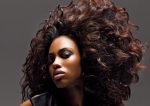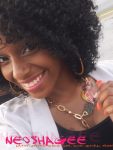Okay. When I did my big chop on March 14, 2011, I had NO idea what I was getting myself into. Like many women that do the big chop, you notice how your hair becomes excessively dry. Not all hair types go through this but I recently found out that I was a 4b/4c. My head is full of kinks, coils, and tight curls. Dysfunctional!!! I’ve learned a lot more since that big day.
I have a regimen that I stick to now. TIP #1-Learn to NOT use shampoos with sulfates in them (causes hair to dry), use cleansers. I did a bit of research last week just for those of you that are having a hard time trying to figure out exactly what your hair type is. The numbers represent the amount of curl in hair. Type 1 is always straight. Here’s a quick breakdown.
Type 1 – Straight Hair
Straight hair reflects most of the silky shine, of course. We all know that much. It is also the most resilient hair of all of the hair types. It is hard to damage and next to impossible to curl this hair texture. People with straight hair are pretty much known to have oily hair. Which makes it hard to keep curls in. Whip out that strong hold hair spray ladies if you’re trying to hold an up-do or massive curls.

Type 2 – Wavy Hair
Wavy hair lies somewhere between straight and curly hair. It also imparts sheen, more than curly hair, but less than straight hair. Wavy hair is more frizz-prone. There are three different wavy hair types in this category. Type A wavies can alternate between styles that are straight and curly. They’re looser waves. Type B and C wavies are more styling-resistent.



Type 3 – Curly Hair
Type 3 curly hair has a definite S shape and may sometimes resemble a Z …however, there is a definite curl pattern in place, with our without products. This type of hair is usually full, climate-sensitive, meaning if it feels humidity you will get frizz, and is prone to damage. A good hair regimen is necessary for keeping your curls fresh and bouncy. There are three sub-categories in this type. Type 3A is a fairly, loosely curled. Type 3B is more jingly with curls and is more bouncy. The newly added type 3C is tighter. Described as being tight corkscrews with much fair movement.



Type 4 – Kinky Hair
Now this hair category can be a mixture of many kinks, coils, curls, and corkscrews. Type 4 hair is also more easily damaged if not taken care of properly. Each strand usually has a zig zag pattern. It appears thick and much more coarser than the other types, but is actually quite fine. A misconception exists that this hair type does not grow. It does indeed grow. Kinky hair grows at the same rate as other textures but just requires much more care. Type 4 hair types are naturally dryer so moisture, moisture, moisture is key when maintaining elasticity and health throughout the hair. Type 4A has a strong S pattern to it and types 4B and 4C are more S and Z patterned, more wiry.



I hope this helped many of you. As with any style, if you want to define your curl pattern, using great curl defining lotions, frizz control oils, serums, and other products will help you to achieve the look you want. Experiment with different brands and products to see what works best for your hair. You can even do like me and research your hair type to find forums or tips and tricks to help you maintain your natural hair. If you have any questions, feel free to comment, email, etc. Good luck beauties!!


